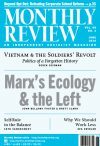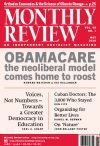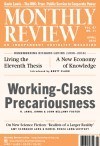Political Economy
Applying a North American Brand to Britain
During the past decade, persistent excess productive capacity, at levels exceeding at times 25 percent, has blighted the British economy, along with rates of unemployment not experienced for two decades, with the result that a substantial proportion of the economy’s productive resources remain underutilized. Orthodox economic theory often ascribes such phenomena to a lack of capital for investment. However, in the same period, interest rates have been historically low, and the UK corporate sector has accumulated increasing reserves of surplus capital. Clearly, there has been no shortage of capital for investment. The failure to invest stems not from the supply of capital, but instead from the paucity of investment opportunities, suggesting that British capitalism is mired in stagnation. | more…
From the 1960s to the Present
In 1964, Paul Baran and Paul Sweezy wrote an essay entitled “Notes on the Theory of Imperialism” for a festschrift in honor of the sixty-fifth birthday of the great Polish Marxist economist Michał Kalecki.… [T]he essay offered the first major analysis of multinational corporations within Marxian theory. Parts of it were incorporated into Baran and Sweezy’s Monopoly Capital in 1966, two years after Baran’s death. Yet for all that book’s depth, “Notes on the Theory of Imperialism” provided a more complete view of their argument on the growth of multinationals. In October and November 1969, Harry Magdoff and Sweezy wrote their article “Notes on the Multinational Corporation,” picking up where Baran and Sweezy had left off. That same year, Magdoff published his landmark The Age of Imperialism, which systematically extended the analysis of the U.S. economy into the international domain.… In the analyses of Baran, Sweezy, and Magdoff, as distinct from the dominant liberal perspective, the multinational corporation was the product of the very same process of concentration and centralization of capital that had created monopoly capital itself. | more…
Marx’s Capital presents a rigorous scientific analysis of the capitalist mode of production and capitalist society, and how they differ from earlier forms. Volume 1 delves into the heart of the problem. It directly clarifies the meaning of the generalization of commodity exchanges between private property owners (and this characteristic is unique to the modern world of capitalism, even if commodity exchanges had existed earlier), specifically the emergence and dominance of value and abstract social labor.… Volume 2 demonstrates why and how capital accumulation functions, more specifically, why and how accumulation successfully integrates the exploitation of labor in its reproduction and overcomes the effects of the social contradiction that it represents.… Volume 3 of Capital is different. Here Marx moves from the analysis of capitalism in its fundamental aspects (its “ideal average”) to that of the historical reality of capitalism.… To move from the reading of Capital (and particularly of volumes 1 and 2) to that of historical capitalisms at successive moments of their deployment has its own requirements, even beyond reading all of Marx and Engels. | more…

Thanks to breakthroughs in production and food science, agribusiness has been able to devise new ways to grow more food and get it more places more quickly. There is no shortage of news items on the hundreds of thousands of hybrid poultry—each animal genetically identical to the next—packed together in megabarns, grown out in a matter of months, then slaughtered, processed, and shipped to the other side of the globe. In Big Farms Make Big Flu, a collection of dispatches by turns harrowing and thought-provoking, Rob Wallace tracks the ways influenza and other pathogens emerge from an agriculture controlled by multinational corporations. | more…

On April 8, 2016, in what has already become a historic case on the climate, Magistrate Judge Thomas Coffin of the United States District Court of Oregon ruled against a motion to dismiss, in favor of the youthful plaintiffs in the Children’s Trust lawsuit (Kelley Cascade Rose Juliana, et al. v. United States of America, et al.) and against the defendants, consisting of the federal government and the fossil-fuel industry.… The defendants’ argument to dismiss was directed principally at what they contended were limits on the federal government’s public trust responsibility. It thus turned on whether the United States was obligated simply to follow capitalist precepts with respect to the natural-physical environment, or whether the government had a public trust to maintain the environment for the population and for future generations, going beyond the rules of the market. | more…
One of the lasting contributions of the Frankfurt School of social theorists, represented especially by Max Horkheimer and Theodor Adorno’s 1944 Dialectic of Enlightenment, was the development of a philosophical critique of the domination of nature.… Yet their critique of the Enlightenment exploitation of nature was eventually extended to a critique of Marx himself as an Enlightenment figure, especially in relation to his mature work in Capital.… So all-encompassing was the critique of the “dialectic of the Enlightenment” within the main line of the Frankfurt School, and within what came to be known as “Western Marxism”…, that it led to the estrangement of thinkers in this tradition not only from the later Marx, but also from natural science—and hence nature itself. Consequently, when the ecological movement emerged in the 1960s and ’70s, Western Marxism, with its abstract, philosophical notion of the domination of nature, was ill-equipped to analyze the changing and increasingly perilous forms of material interaction between humanity and nature. | more…
A Broader Challenge to Corporate School Reform
As the corporate takeover of public schools proceeds apace on a global scale, so too does the grassroots resistance. In the United States…. [o]ver 600,000 parents opted their children out of the tests in spring 2015; students have launched walkouts and boycotts; school boards are passing resolutions against overtesting; and teachers at a Seattle high school collectively refused to administer a test they deemed harmful to instruction. These actions and more demonstrate the hope and promise of public schools as sites for resilience and democratic resistance, even as corporate interests tighten their grip on schools under cover of “education reform.” This article reflects strategically on the fight for public education, with a special focus on the Opt Out movement, which was recently the subject of a special issue of Monthly Review. My treatment applauds opting out as a tactic in an organizing toolkit, but rejects it as a strategy, and takes issue with the analysis of corporate school reform proffered by the leading advocates of Opt Out. | more…
Paul Street, They Rule: The 1% vs. Democracy (London: Routledge, 2014), 252 pages, $30.95, paperback.
In They Rule, Paul Street offers a thorough deconstruction of the status quo of U.S. capitalism. The book’s subtitle gives a nod to the Occupy Wall Street movement, whose main victory was to popularize the concept of U.S. class conflict, as embodied in the “1 percent.” The title also recalls John Carpenter’s 1987 film They Live, a sci-fi spoof of the Reagan era that prefigured the Occupy revolt. Carpenter’s characters don “magic sunglasses” for intellectual defense against media misinformation.… One current form of that misinformation is the view that the Democratic Party exercises “left” politics. Street smashes this notion.… [However,] this is no academic query. | more…

A little less than two years ago, in July-August 2014, Monthly Review published a special summer issue under the title Surveillance Capitalism, edited by John Mage.… The lead article by Foster and McChesney was itself entitled “Surveillance Capitalism: Monopoly-Finance Capital, the Military-Industrial Complex, and the Digital Age.” In Foster and McChesney’s analysis, the problem of surplus absorption under monopoly capital was seen as having led to the development over the last seven decades of a massive surveillance network, extending across the sales effort, finance, and the military, and integral to the entire information economy.… We were therefore pleased to discover that the concept of “surveillance capitalism” has now entered the mainstream and is drawing considerable attention, through the work of Shoshana Zuboff, emeritus professor at the Harvard Business School.… ” She failed, however, to mention the prior treatment of “surveillance capitalism” in Monthly Review, despite the fact that her analysis was written in November 2014—judging by her accessing of numerous articles on the Internet on that date—four months after the MR issue was published and posted online.… | more…
The Neoliberal Model Comes Home to Roost in the United States—If We Let It
As the Affordable Care Act (ACA, otherwise known as Obamacare) continues along a very bumpy road, it is worth asking where it came from and what comes next. Officially, Obamacare represents the latest in more than a century of efforts in the United States to achieve universal access to health care. In reality, Obamacare has strengthened the for-profit insurance industry by transferring public, tax-generated revenues to the private sector. It has done and will do little to improve the problem of uninsurance in the United States; in fact, it has already begun to worsen the problem of underinsurance. Obamacare is also financially unsustainable because it has no effective way to control costs. Meanwhile, despite benefits for some of the richest corporations and executives, and adverse or mixed effects for the non-rich, a remarkable manipulation of political symbolism has conveyed the notion that Obamacare is a creation of the left, warranting strenuous opposition from the right. | more…
We have finally reached the point where most people around the world believe that climate change is really happening. Almost a decade ago, the landmark report by Nicholas Stern sparked a fierce debate among economists, not over whether climate change was real, but over the costs of addressing it. In the years since, the Intergovernmental Panel on Climate Change (IPCC) has published further alarming reports on projected future global temperatures, rates of glacial melting, and sea levels. Most recently, last December saw an unprecedented agreement by nearly 200 countries at the Paris climate summit to take steps to address the problem.… My concern here is therefore not to continue making the case for the reality of climate change, but instead to show how that reality is portrayed—and distorted—in the mainstream media, with behind-the-scenes assistance from orthodox economic analysis. | more…

The March/April 2016 issue of Foreign Affairs, published by the Council on Foreign Relations, is devoted in large part to the topic of economic stagnation.… [Of the] eight articles on stagnation, only one…—”The Age of Secular Stagnation” by Lawrence H. Summers—is, in our opinion, of any real importance.… Summers heavily criticizes those like Robert J. Gordon, in The Rise and Fall of American Growth (2016), who attribute stagnation to supply-side “headwinds”…blocking productivity growth.… Likewise Summers dispatches those like Kenneth Rogoff who see stagnation as merely the product of a debt supercycle associated with periodic financial crises.… Despite such sharp criticisms of other mainstream interpretations of stagnation, Summers’s own analysis can be faulted for being superficial and vague, lacking historical concreteness.… In fact, the current mainstream debate on secular stagnation is so superficial and circumspect that one cannot help but wonder whether the main protagonists—figures like Summers, Gordon, Paul Krugman, and Tyler Cowen—are not deliberately tiptoeing around the matter, worried that if they get too close or make too much noise they might awaken some sleeping giant (the working class?) as in the days of the Great Depression and the New Deal. | more…



